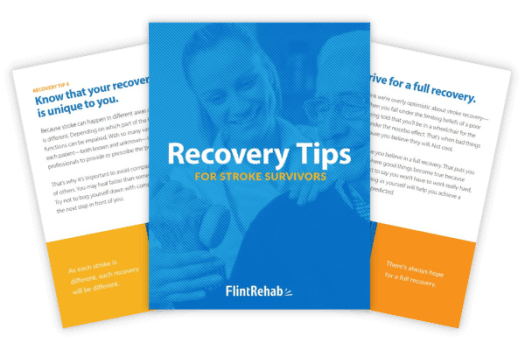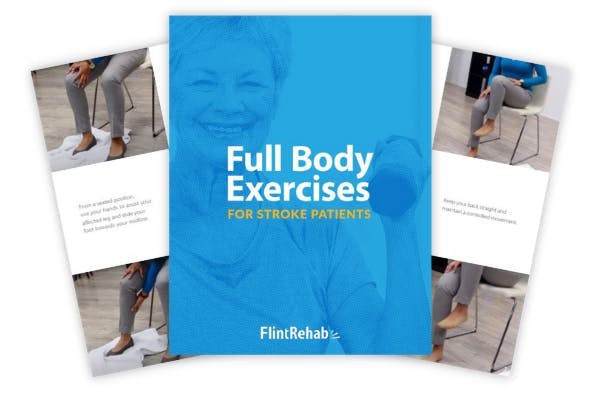No products in the cart.
No products in the cart.
No products in the cart.
No products in the cart.
Home » Neurological Recovery Blog » Stroke » 7 Signs of Recovery from Stroke: How to Know When You’re on the Right Track
Last updated on June 28, 2022

You’ve probably heard your therapist mention that every stroke is different and therefore every recovery will also be different. This makes it hard to know what to expect on the road to recovery. What does it look like when someone is improving? What does it mean if symptoms regress? Are there any signs of recovery from stroke that you can look for?
To help shine some essential light, you’re about to discover some of the most common signs of recovery from stroke. Keep in mind that it’s important not to compare your recovery journey to anyone else’s. The results and timeline you experience will be different than others.
Also, while most steps along your road to recovery will be improvements, you may also experience some momentary times of regression along the way. If you ever become concerned about backsliding, be sure to talk to your therapist or doctor. If symptoms are urgent, seek emergency medical attention.
When a stroke occurs, the blood supply in the brain becomes compromised, resulting in damage to some of the brain tissue. This damage creates secondary effects like weakness on one side of the body (hemiparesis), speech difficulties, or other complications.
The goal of stroke rehabilitation is to improve these secondary effects to the best of your ability. This is where multidisciplinary therapy comes into play. Survivors can address the effects of a stroke by participating in different therapies such as physical, occupational, and/or speech therapy.
The road to recovery can be long, especially if you have more than one area you need to address, as most survivors do. Fortunately, the brain is capable of healing itself through the process of neuroplasticity. This allows many of the secondary effects of a stroke to be remedied, at least partially if not fully, through a rigorous and consistent rehabilitation program.
At the beginning of your recovery journey, you will be guided by a team of therapists that will help you understand what to expect. Once you’re discharged home, though, recovery is in your hands.
It can be helpful to understand the signs of recovery from stroke so that you can celebrate the wins when they come. Recovering functions after a stroke is no small feat, and every inch of progress should be celebrated.
Again, every stroke is different and therefore every recovery is different. The signs of recovery from stroke vary from person to person.
However, it’s still helpful to understand some common patterns that occur during recovery. This can help prepare you for some of the challenges and opportunities ahead.
Here are some of the most common patterns and signs of recovery from stroke:
While everyone recovers from stroke at a different pace, there’s a well-known phenomenon referred to as the stroke recovery plateau. Most stroke survivors experience the fastest gains during the first 3 months of recovery; after that, progress starts to slow down or “plateau.”
Rest assured that as long as you continue rehabilitation, progress will generally continue – just at a slower pace. It’s important to acknowledge that, when recovery slows down, it’s not a bad sign! In fact, it can be viewed as a sign of recovery from stroke, because it means that initial burst of results has occurred, and recovery can continue as long as you continue with therapy.
After a stroke, you may become dependent upon others to perform self-care tasks such as eating, getting dressed, or bathing. These tasks are often referred to as the activities of daily living.
When a stroke survivor becomes more independent with the activities of daily living, it’s a great sign of recovery after stroke. It means that the improvements from therapy have translated to your everyday life. Although everyone involved in your recovery journey will see this as excellent progress, becoming more independent with activities of daily living demonstrates that you’ve made gains through occupational therapy in particular.
Since the primary goal of occupational therapy is to be as independent as possible with your daily tasks, your occupational therapist is a great resource in this area. Your therapist can create a custom rehabilitation plan for you, as well as teach you about adaptive strategies and tools to use to compensate for areas in which your progress is slow. If you share your improvements with them, they can also celebrate your wins when you experience signs of recovery after stroke.
Excessive sleepiness after stroke is common. After the brain sustains trauma, it takes energy to heal. This often causes stroke survivors to crave much more sleep than before, which could be seen as a bad thing unless you know otherwise. And now you do!
Sleep gives the brain time to recover and facilitates neuroplasticity. As the brain is recovering after stroke, you may become physically or mentally fatigued easily. This could actually be a good sign of recovery because it could mean that the brain is working hard and needs rest to recuperate.
Be sure to listen to your body and sleep when you need sleep. If your body is asking for it – you probably need it. The only reason to ever consider limiting your sleep is if too many daytime naps interfere with nighttime sleep. But if your body asks for sleep, and you have no trouble sleeping, then keep on.
Getting plenty of sleep is the #1 recommendation from Jilly Bolte Taylor, a brain scientist and stroke survivor most famous for delivering her most-watched TED Talk (and now stroke recovery book), “My Stroke of Insight.”
Beware that if excessive sleepiness is not coupled with an overarching pattern of progress, then it could be a sign that something is wrong. In either case, it’s best to keep a detailed log of what’s happening and consult your doctor or therapist.
Compensatory techniques include aids or “shortcuts” that allow a stroke survivor to accomplish tasks in a different way. It’s a good sign of recovery from stroke when a survivor transitions from using a compensatory technique to doing something just like they did before injury.
For example, using a walker or a cane to get around is a compensatory technique. Cooking with only one hand is also a compensatory technique, because normally we use two hands.
While compensatory strategies are essential because they keep us safe (like how canes protect us from falling) and allow us to be independent (we can cook one-handed versus not cooking at all), they can also limit recovery. That’s why it’s important to stay curious about whether or not you need to be using compensatory techniques.
There may come a day where you can safely cook with two hands, but you might miss the opportunity unless you remain constantly curious. Continue to ask yourself: Is this how I need to accomplish this task, or can I try safely approaching this task as I did before injury? If safety could be compromised by not using a compensatory strategy, consider asking your therapist or a family member to be nearby the first few times you try doing a task without any extra aids.
Another surprising sign of recovery after stroke could involve muscle twitching. Sometimes, muscle twitches signify that spasticity is improving. However, it can also indicate other conditions such as post-stroke tremors. It’s important to keep track of any symptomatic changes and notify your therapist or doctor if you are concerned.
Spasticity is a post-stroke condition that involves stiff, tight muscles. It occurs when the brain cannot properly communicate with the affected muscles due to the neurological damage from stroke.
When spasticity improves, muscles may start to twitch, as outlined in the Brunnstrom stages of stroke recovery. Flaccidity, or paralysis, is the first stage of recovery. In order for survivors to regain movement after post-stroke paralysis, they must move through the second stage of recovery, which includes spasticity.
In other words, generally a survivor with post-stroke paralysis develops spasticity before regaining movement, then must work to reduce spasticity in order to continue improving mobility.
Therefore, it could be a good sign of recovery from stroke when muscles begin to twitch, especially if the survivor has been pursuing therapy to regain mobility after paralysis.
Of course, it’s important to talk to your therapist if/when this happens to make sure that it’s a good sign of recovery and not an indication of other post-stroke complications like tremors. Even if you think it’s a good sign of recovery, it’s best to err on the side of caution.
Want 20 pages of stroke recovery tips in an illustrated PDF? Download our free ebook by clicking here (link opens a pop up for uninterrupted reading)
The physical effects of a stroke typically get the most attention because they directly impact your independence. However, the emotional effects of a stroke also deserve attention.
A stroke is a life changing event that can result in losses, such as the loss of independence, beloved hobbies, or even relationships. This can push some survivors into grief.
There are 5 stages of grief after stroke that often occur. Two of these stages include anger and depression. While negative emotions are often viewed as a bad thing, when it comes to stroke recovery, they may be a sign of progress. Each of the stages of grief often need to be experienced before emotional recovery is achieved. The only way out is through.
Therefore, when stroke survivors experience emotions such as anger and depression, it could mean they are moving through the stages of grief; and that they are one step closer to the final stage: acceptance.
However, it’s important to take the right steps to ensure that you are supported and do not get stuck in anger or depression. It often helps to join a stroke support group and seek psychological care when appropriate, such as talk therapy.
Although this is not a hard rule, studies have found that the ability to cross your legs within 15 days after a stroke was found to be a good sign of recovery.
However, this does not mean you will have a poor recovery if you cannot cross your legs after a stroke. It just means there may be more work to be done.
For example, Becky is a brain stem stroke survivor who was completely paralyzed from her nose down (a condition known as locked-in syndrome). She could not cross her legs within 15 days after her stroke because she was in a coma after stroke for a full month.
However, when she woke up, she had complete use of her right side and partial use of her left side. She is pursuing recovery to regain as much mobility as possible, and she’s still going eleven years later!
Becky is a perfect example that every stroke is different, and therefore every recovery is different. Even if you don’t hit any of the particular milestones listed in this article, don’t assume recovery is out of reach. Keep putting in the work and pursue recovery anyway, and you’ll be able to see how far you can go.
Hopefully these signs of recovery from stroke help you identify and celebrate milestones in your recovery. While the timeline in which you may experience them is different among survivors, the best way to maximize your chances of recovery is to keep pursuing therapy.
To help you keep improving, here are some tips to promote recovery from stroke:
In addition to the tips above, having a log of your symptoms and experiences can help during visits with your doctor or therapist. For example, if you experience muscle twitching, having a log of when this symptom first started can be very helpful for your medical team.
Overall, the road to recovery looks different for everyone. It’s important to do everything you can to keep recovering, and try not to compare your recovery journey with that of someone else.
If you are able to cross your legs, that’s typically a good sign of recovery. But not all signs of recovery are positive. Sometimes, excessive sleepiness and negative emotions are actually good signs of recovery, too.
Because some of these signs could also signify a medical problem, it’s important to communicate everything with your therapist and medical team. They can make sure you’re on the right track, and help you to continue to progress down the road to recovery.

Get our free stroke recovery ebook by signing up below! It contains 15 tips every stroke survivor and caregiver must know. You’ll also receive our weekly Monday newsletter that contains 5 articles on stroke recovery. We will never sell your email address, and we never spam. That we promise.


Do you have these 25 pages of rehab exercises?
Get a free copy of our ebook Full Body Exercises for Stroke Patients. Click here to get instant access.
“My name is Monica Davis but the person who is using the FitMi is my husband, Jerry. I first came across FitMi on Facebook. I pondered it for nearly a year. In that time, he had PT, OT and Speech therapy, as well as vision therapy.
I got a little more serious about ordering the FitMi when that all ended 7 months after his stroke. I wish I hadn’t waited to order it. He enjoys it and it is quite a workout!
He loves it when he levels up and gets WOO HOOs! It is a wonderful product! His stroke has affected his left side. Quick medical attention, therapy and FitMi have helped him tremendously!”
FitMi is like your own personal therapist encouraging you to accomplish the high repetition of exercise needed to improve.
When you beat your high score or unlock a new exercise, FitMi provides a little “woo hoo!” as auditory feedback. It’s oddly satisfying and helps motivate you to keep up the great work.
In Jerry’s photo below, you can see him with the FitMi pucks below his feet for one of the leg exercises:
Many therapists recommend using FitMi at home between outpatient therapy visits and they are amazed by how much faster patients improve when using it.
It’s no surprise why over 14,000 OTs voted for FitMi as “Best of Show” at the annual AOTA conference; and why the #1 rehabilitation hospital in America, Shirley Ryan Ability Lab, uses FitMi with their patients.
This award-winning home therapy device is the perfect way to continue recovery from home. Read more stories and reviews by clicking the button below:
Grab a free rehab exercise ebook!
Sign up to receive a free PDF ebook with recovery exercises for stroke, traumatic brain injury, or spinal cord injury below: